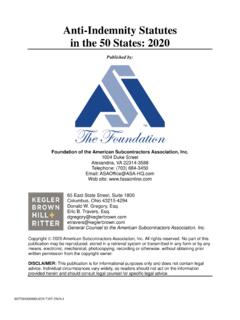Transcription of Annual Benefit Corporation Report - Patagonia, Inc.
1 Annual Benefit CorporationReportFiscal Year 2019 May 1, 2018 April 30, 2019 IntroductionPatagonia Works ( Patagonia ) is an outdoor apparel company with a more than 40-year history of environmental conservation and activism. In 2018, we changed our mission statement to amplify this directive: We re in business to save our home planet. Patagonia became a registered Benefit Corporation in 2012, on the first day we were legally able to in the state of California. In doing so, Patagonia and our subsidiaries, Patagonia, Inc., Great Pacific Iron Works, Patagonia Provisions, Inc.
2 And Fletcher Chouinard Designs, Inc., adopted six specific Benefit purpose commitments (which you ll find listed and described within) that govern our operations at the most fundamental level. This Report shares the work we ve done during our fiscal year 2019 (May 1, 2018 April 30, 2019) to advance public Benefit and implement our specific Benefit for the Planet 3 Build the Best Product with No Unnecessary Harm 6 Conduct Operations Causing No Unnecessary Harm 10 Sharing Best Practices with Other Companies 13 Transparency 16 Providing a Supportive Work Environment 19In Closing 23 Patagonia Benefit Purposes23 Fiscal Year 2019 Annual Benefit Corporation Report1% for the Planet Each year, we contribute one percent (1%)
3 Of our Annual net revenues to nonprofit charitable organizations that promote environmental conservation and sustainability. 41% for the Planet A nonprofit we co-founded in 2002 that commits Patagonia to donating 1% of net revenues in cash and in-kind donations every year, primarily to grassroots environmental nonprofits.$116,000,000 Dollars, and dollar value of other forms of assistance, given to support environmental work since we started our tithing program in 1985.$10,000,000 Dollars of donations we made on top of our 1% commitment, using money we saved as the result of the Trump administration s corporate tax Grants funded in FY19 to 929 Employees who are actively involved in grant-making and deciding which environmental organizations Patagonia supports.
4 $5,000,000+ In grants made to groups fighting to protect lands and waters. $400,000+ In grants made to groups working to advance renewable energy.$1,000,000+ In grants made to groups working to scale many of the tenets of regenerative organic agriculture and help more farmers implement practices to improve soil for the PlanetHighlights$10 Million Tax CutFor decades, Patagonia has paid what we call a self-imposed Earth Tax through our commitment to donate 1% of sales each year for the planet. Those funds go directly to thousands of scrappy, dedicated groups of people around the world fighting to protect their own backyards.
5 Why? Because we believe these seemingly small battles are the most effective way to advance complicated environmental issues in the public mind. We also pay our fair share of federal and state taxes. This past year, when the Trump administration initiated a corporate tax cut, threatening critical services (including those required to support the health of our planet), Patagonia took $10 million of the taxes saved and, instead of putting the money back into our business, put it back to work for the planet. As a result, in FY19 we gave away an additional $10 million on top of our regular 1%, to nonprofits committed to protecting air, land and water and finding solutions to the climate crisis.
6 Our home planet needed this break more than we do. Fighting for takayna / TarkineIn May 2018, the Patagonia Australia team launched takayna, a film about the fight for an ancient rainforest in northwestern Tasmania and the future of one of our last wild places. Tens of thousands of people watched the film online and 270,000 signed our petition urging the premier of Tasmania to nominate takayna / Tarkine for World Heritage protection. We hosted rallies and events to support the cause, culminating in a race along the rugged takayna / Tarkine coastline. Pro runners and Patagonia ambassadors Krissy Moehl (USA) and Grant Guise (New Zealand) ran in support of protecting takayna / Tarkine as a World Heritage Area.
7 Runners raised over $100,000 to support the Bob brown Foundation, a grassroots environmental group dedicated to protecting Australia s wild and scenic natural places of ecological and global significance. Saving the Blue Heart of EuropeIn 2018, Patagonia Europe launched its Blue Heart of Europe campaign, aimed at protecting the Balkan region from more than 3,000 proposed hydropower projects and bringing international awareness to the issue. The multimedia campaign included a website, a documentary film and a petition that delivered 125,000 signatures to the headquarters of the European Bank for Reconstruction and Development in London, one of the big financial stakeholders in the project.
8 One year later, the European Bank for Reconstruction and Development adopted stricter transparency standards for loans granted for renewable energy projects, specifically for small hydropower plants in the Balkans. In addition, in December the European Parliament passed a resolution highlighting the environmental risks of small hydropower dams and pointing out that they are not in line with the European Union s own environmental standards. And the Council of Europe s environmental watchdog (the Bern Convention Convention on the Conservation of European Wildlife and Natural Habitats)
9 Called on the Albanian government to halt the hydropower dams on the Vjosa River and recommended that the issue be examined by a group of experts to develop principles for hydropower plants in protected Change and Public Lands On February 13, 2019, Patagonia s director of environmental campaigns and advocacy, Hans Cole, testified to the House Committee on Natural Resources, Subcommittee on National Parks, Forests, and Public Lands at a hearing titled Climate Change and Public Lands: Examining Impacts and Considering Adaptation Opportunities. On the same day, we delivered a letter to all members of Congress outlining Patagonia s policy priorities as they relate to the climate crisis.
10 One of these priorities is protection of our nation s public lands and waters. An average of 24% of all national emissions of carbon come from fossil fuels produced on federal lands and offshore waters. As a result, land and water protection can directly reduce our climate impact while contributing significantly to long-term carbon storage and climate resilience for wildlife and humans alike. During the same week that our testimony was delivered in , the John D. Dingell, Jr. Conservation, Management, and Recreation Act of 2019 a bill championed by Patagonia and many of our grantees was also moving through Congress.








